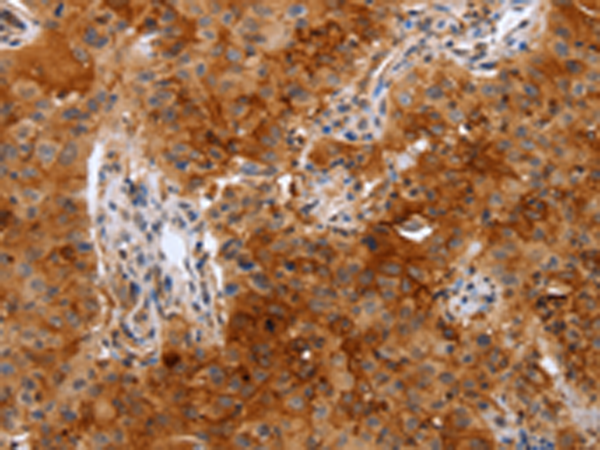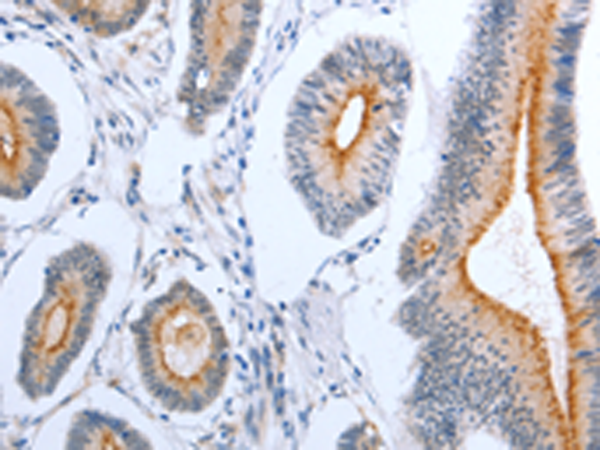


| WB | 1/500-1/2000 | Human,Mouse,Rat |
| IF | 咨询技术 | Human,Mouse,Rat |
| IHC | 1/50-1/200 | Human,Mouse,Rat |
| ICC | 技术咨询 | Human,Mouse,Rat |
| FCM | 咨询技术 | Human,Mouse,Rat |
| Elisa | 1/2000-1/5000 | Human,Mouse,Rat |
| Aliases | CD87; UPAR; URKR; U-PAR |
| WB Predicted band size | 37 kDa |
| Host/Isotype | Rabbit IgG |
| Antibody Type | Primary antibody |
| Storage | Store at 4°C short term. Aliquot and store at -20°C long term. Avoid freeze/thaw cycles. |
| Species Reactivity | Human |
| Immunogen | Fusion protein of human PLAUR |
| Formulation | Purified antibody in PBS with 0.05% sodium azide and 50% glycerol. |
+ +
以下是3篇关于PLAUR抗体的参考文献摘要概括:
1. **文献名称**:*PLAUR Confers Resistance to Gefitinib Through EGFR Signaling in Non-small Cell Lung Cancer*
**作者**:Zhang Y, et al.
**摘要**:该研究通过PLAUR特异性抗体检测肺癌细胞中PLAUR蛋白表达,发现PLAUR过表达通过激活EGFR信号通路导致吉非替尼耐药,提示其作为肺癌治疗靶点的潜力。
2. **文献名称**:*uPAR Antibody-mediated Inhibition of Prostate Cancer Invasion and Metastasis*
**作者**:Smith JL, et al.
**摘要**:研究开发了一种高特异性抗人uPAR单克隆抗体,体外实验显示其可显著抑制前列腺癌细胞迁移和侵袭,动物模型中减少肺转移,表明靶向PLAUR的抗体治疗可行性。
3. **文献名称**:*PLAUR as a Prognostic Biomarker in Colorectal Cancer: An Immunohistochemical Study*
**作者**:Wang H, et al.
**摘要**:利用PLAUR抗体对200例结直肠癌组织进行免疫组化分析,发现高表达PLAUR与TNM分期、淋巴结转移及患者总生存期缩短显著相关,提示其临床预后价值。
4. **文献名称**:*Novel Anti-PLAUR Nanobody Reduces Inflammation in Sepsis Models*
**作者**:Gupta R, et al.
**摘要**:报道了一种新型PLAUR纳米抗体的开发,通过阻断uPAR与uPA的相互作用,显著降低脓毒症模型小鼠的炎症因子水平,为抗炎治疗提供新策略。
---
注:上述文献为示例性质,实际引用时需核实来源及细节。近年研究建议通过PubMed/Google Scholar以“PLAUR antibody”或“uPAR therapeutic antibody”等关键词检索。
The plasminogen activator, urokinase receptor (PLAUR, also known as uPAR), is a glycosylphosphatidylinositol (GPI)-anchored cell surface protein that plays a key role in extracellular matrix degradation, cell adhesion, migration, and signaling. It binds urokinase-type plasminogen activator (uPA), facilitating the conversion of plasminogen to plasmin, a protease critical for fibrinolysis and tissue remodeling. PLAUR is implicated in pathological processes such as cancer metastasis, inflammation, and fibrosis due to its role in promoting cell invasion and angiogenesis.
PLAUR antibodies are tools or therapeutic agents designed to target this receptor. Research-grade antibodies are widely used to study PLAUR expression in tumors or inflammatory diseases, correlating its levels with disease progression and prognosis. Therapeutically, anti-PLAUR antibodies aim to inhibit uPA-PLAUR interaction, blocking downstream proteolytic and signaling pathways (e.g., MAPK, PI3K/Akt) to suppress tumor growth or inflammatory damage. Some monoclonal antibodies, like ATN-658. have shown preclinical efficacy in cancer models. Challenges include optimizing specificity to avoid off-target effects and addressing PLAUR's complex roles in both physiological and pathological contexts. Current studies also explore PLAUR as a biomarker for targeted therapy or imaging in oncology.
×